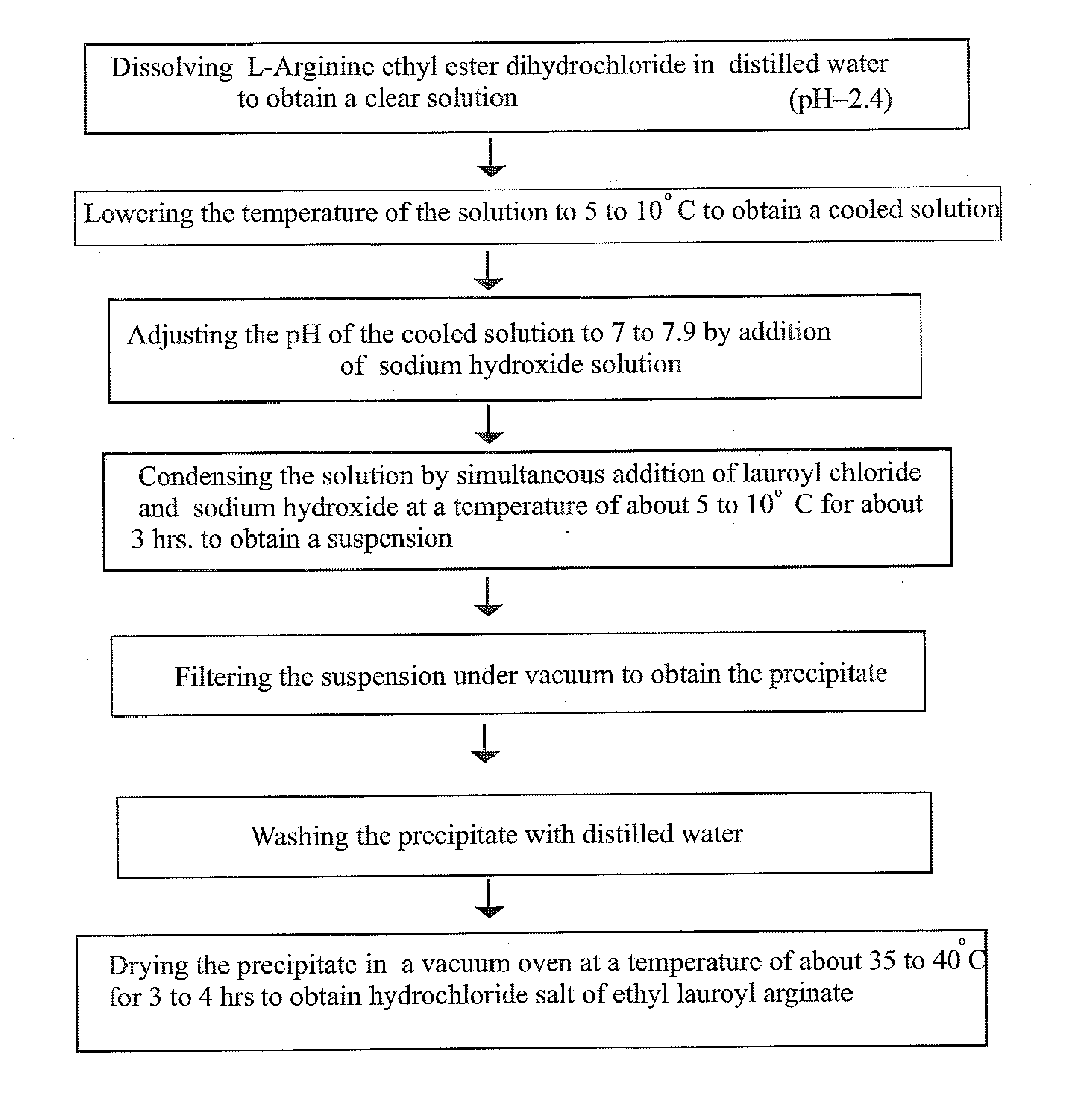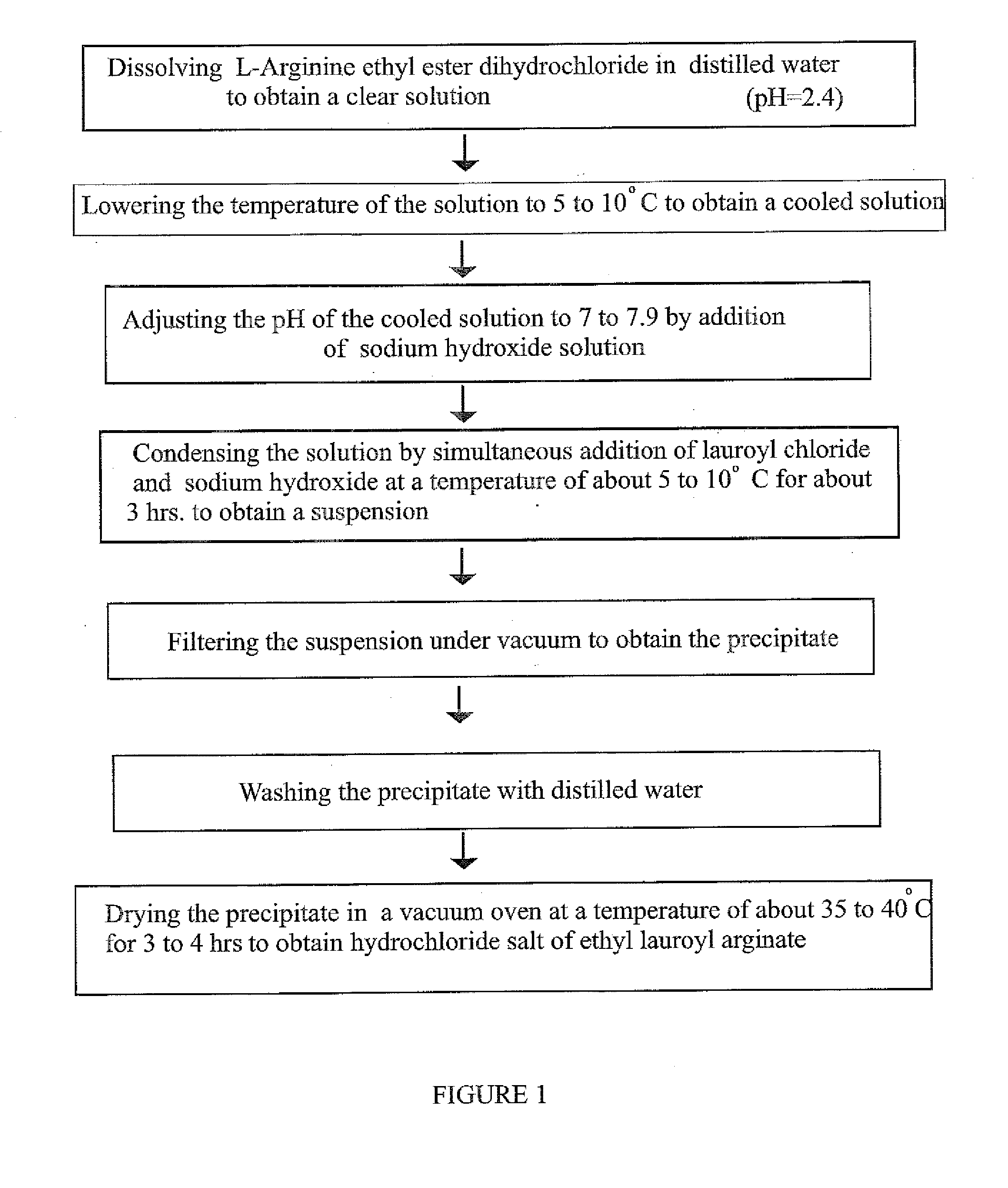Process for synthesis of cationic surfactants
a technology of cationic surfactants and synthesis methods, applied in the field of synthesis of cationic surfactants, can solve the problems of low yield obtained in these prior art processes, inability to provide a comparatively pure product, and long process cycles, so as to achieve the effect of improving yield and purity
- Summary
- Abstract
- Description
- Claims
- Application Information
AI Technical Summary
Benefits of technology
Problems solved by technology
Method used
Image
Examples
example 1
[0107]47.1 gm of L-arginine ethyl ester dihydrochloride was transferred to a flask containing 300 gm of water and was stirred for 10 minutes to obtain a clear solution. This solution was cooled to 8° C. Further, 75 gm of 20% sodium hydroxide solution was taken in an addition funnel and 37.5 gm of lauroyl chloride was charged in another addition funnel. The pH meter electrode was dipped into the ethyl ester solution in the flask. The pH of the solution was 2.4. Then pH of the solution was adjusted to 7.5 by adding 20% sodium hydroxide solution. To this solution, lauroyl chloride and 20% sodium hydroxide were added simultaneously at a temperature of about 8° C. and the pH of the solution was maintained to 7.3. The addition of lauroyl chloride and 20% sodium hydroxide solution was carried out for 3 hours to obtain a solution containing thick white precipitate. The solution was then slowly allowed to attain the temperature of about 19° C. and held for 1 hour. The pH of the solution was ...
example 2
[0109]47.1 gm of L-arginine ethyl ester dihydrochloride was transferred to a flask containing 300 gm of water and was stirred for 10 minutes to obtain a clear solution. This solution was cooled to 8° C. Further, 75 gm of 20% sodium hydroxide solution was taken in an addition funnel and 37.5 gm of lauroyl chloride was charged in another addition funnel. The pH meter electrode was dipped into the ethyl ester solution in the flask. The pH of the solution was 2.4. The pH of the solution was adjusted to 7.5 by adding 20% sodium hydroxide solution. To the solution, lauroyl chloride and 20% sodium hydroxide were added simultaneously at the temperature of about 8° C. to 10° C. and the pH of the solution was maintained to 7.5. The addition of lauroyl chloride and 20% sodium hydroxide solution was carried out for 3 hours to obtain the solution containing trace white precipitate of (LAS). The solution containing thick white precipitate was then slowly allowed to attain the temperature of about...
example 3
[0110]The process of example 1 was repeated except that pH of the solution was maintained to 5.7 and adjusted to 5.5 by addition of few drops of 10% hydrochloric acid solution. The obtained white precipitate of ethyl lauroyl arginate hydrochloride was dried for a period of 12 hours.
[0111](% Yield—84, HPLC purity—91.65%)
PUM
| Property | Measurement | Unit |
|---|---|---|
| temperature | aaaaa | aaaaa |
| temperature | aaaaa | aaaaa |
| temperature | aaaaa | aaaaa |
Abstract
Description
Claims
Application Information
 Login to View More
Login to View More - R&D
- Intellectual Property
- Life Sciences
- Materials
- Tech Scout
- Unparalleled Data Quality
- Higher Quality Content
- 60% Fewer Hallucinations
Browse by: Latest US Patents, China's latest patents, Technical Efficacy Thesaurus, Application Domain, Technology Topic, Popular Technical Reports.
© 2025 PatSnap. All rights reserved.Legal|Privacy policy|Modern Slavery Act Transparency Statement|Sitemap|About US| Contact US: help@patsnap.com



